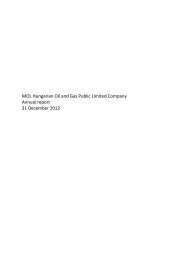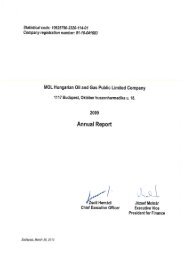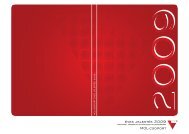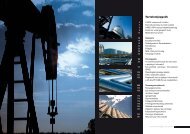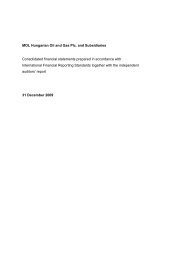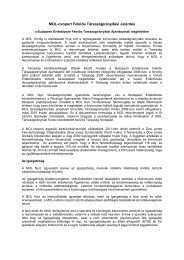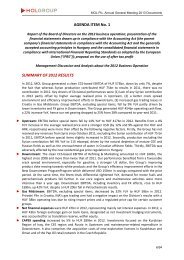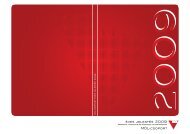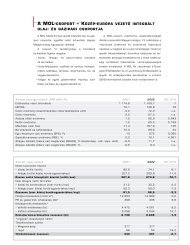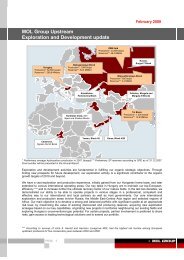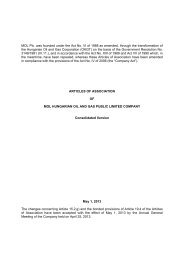MOL GROUP Annual Report
MOL GROUP Annual Report
MOL GROUP Annual Report
- No tags were found...
Create successful ePaper yourself
Turn your PDF publications into a flip-book with our unique Google optimized e-Paper software.
Unit OPEX slightly increasedStrongest acreage position in Hungaryand CroatiaContinued strong exploration trackrecordPromising exploration projects at theCroatian and Hungarian borderNew partnerships in conventionalexploration2011 work program includes drilling of further wells, commencement of gaspower generation project on Ras Qattara and start of initial production on Rizkdevelopment lease.The 2010 annual average unit OPEX (with exclusion of DD&A) was 6.6 USD/boeon Group level while without INA it increased by 0.4 USD/boe to 5.6 USD/boecompared to 2009 mostly due to higher costs.Intensive exploration activity was carried out in Hungary and we continued withour international exploration projects. In 2010 main activities were carried out inKurdistan Region of Iraq, Syria, Croatia, Pakistan, Kazakhstan, Cameroon andRussia.As at 31 December 2010, the <strong>MOL</strong> Group had 24 exploration licenses coveringmore than 27,292 square kilometres in Hungary keeping his dominant role in thecountry. In addition, through its subsidiaries the <strong>MOL</strong> Group participates in theexploration of numerous international exploration blocks located in 13 countries.The Group also has right to explore hydrocarbons in eight onshore blocks, coveringa total area of approximately 59,516 square kilometres and in three offshoreblocks with a total area of 39,813 square kilometres in Croatia.Our strong Group level exploration track record, already observed in thepreceding year, continued further in 2010 as we claimed 14 discoveries out ofa total 20 exploration wells tested in 7 countries, leading to a solid 70% successrate at the drill-bit. In Pakistan, we drilled 1 exploration well in 2010, whichresulted in a commercial discovery, while drilling of another well started in 2010and it was published as commercial discovery in Q1 2011. In Kurdistan Regionof Iraq 2 exploration wells were drilled, both of them resulted in discoveries. InEgypt 3 exploration wells were drilled, 1 of them resulted in discovery. In Croatia2 exploration wells were drilled, both of them deemed successful. In Syria oneexploration well was tested and resulted in discovery in 2010.Our conventional exploration activity in Central Europe reached an outstanding75% success rate in 2010. In Hungary, out of the 10 exploration wells tested in2010, 6 wells were classified as gas producers, 1 well as oil producer addingapproximately 4.1 MMboe to our SPE 2P reserve base. Three wells were qualifiedas dry. Well-test of one well, drilling of which started in 2010, was completed inQ1 2011 and was classified as successful, while one further well is waiting for testin Hungary at the close of this report. In Croatia there were 2 successful onshoredrillings (1 gas and 1 oil producer).In recent years INA’s conventional Croatian onshore exploration activities havefocused on evaluation of less risky prospects located near producing areas in thePannonian Basin. In Zalata – Podravska Slatina area at the Croatian-Hungarianborder, testing of Dravica-1 well was finished, resulting in a gas discovery;furthermore 3D seismic works were also completed. At Novi Gradac – Potonylicense area at the Croatian-Hungarian border, testing of Potony-1 well (inHungary) finished, which became dry. Exploration period was extended by 1 year,effective until August 31, 2011. At Selec-1 on the Sava Depression, one well wasdrilled and tested in 2010, resulting in oil discovery.<strong>MOL</strong> in combined efforts with Expert Petroleum has won the bid for threeexploration blocks in Romania. Negotiations with the Romanian Authority(NAMR) about the Concession Agreements are ongoing. In 2010 a ParticipationAgreement has been signed to re-develop and rehabilitate gas and condensatereservoirs across the Romanian-Hungarian border in joint efforts. A PreliminaryField Study and work program proposals have been discussed. <strong>MOL</strong> and CentralUnconventional exploration focusedon Derecske BasinAdriatic offshore explorationMajor discovery in the KurdistanRegion of IraqFurther exploration successes inPakistanEuropean Oil Company (CEOC) signed a Head of Terms in 2010 for rehabilitationand re-development works on 6 oil and gas fields in Hungary.Key focus in unconventional exploration was on Derecske Basin in 2010. <strong>MOL</strong>has launched an exploration program by drilling two wells, which both provedthe presence of hydrocarbons in tight reservoirs and already producing gas fromunconventional reservoirs. In 2010 the Derecske project continued by drilling twowells. The first well proved the presence of gas and is ready for the fracturing ofthe reservoir for commercial production. The second well, explored more riskypart of the reservoir the well data are currently under evaluation.In Makó trough previous exploration wells have not justified the preliminaryexpectations and in 2010, after the evaluation of test data and the re-evaluationof the potential in Makó trough, our partnership was terminated with ExxonMobil.In 2010 <strong>MOL</strong> fulfilled its obligations and submitted final geological reports for thetwo exploratory licenses. <strong>MOL</strong> provided potential estimations to the Authority tosecure the licenses for further activity.In 2010 at Békés Basin (where the play is similar to Makó) data of Gyula-1 well drilledand fractured by Exxon and the data of Szabadkígyós-1 well were exchanged. Thechance for successful exploration has higher probability in the block compared toMakó trough. In 2010 <strong>MOL</strong> submitted a final report to the Authority for Block 101with calculations on unconventional potential, which report was approved.Exploration activity was continued on offshore Ivana Block, Croatia in partnershipwith ENI in 2010. In order to explore further gas potential the investigation of thinlayer-typereservoirs was carried out on Ivana Block during 2010, resulting in IvanaSW Thin-Layer Study. Two locations of exploratory wells were proposed; and thetechnical program has been prepared for the first one. 2010 exploration activitiesalso included the start of new G&G interpretation of thin-layer-type reservoirs,post-drilling activities connected to IKA SW2 Dir, and commencement of tworegional studies (geochemical and mineralogical).In the Kurdistan Region of Iraq <strong>MOL</strong> is the operator of Block Akri-Bijeel with anundiluted working interest of 80% and has a 20% non-operated working interestin Block Shaikan. In the Akri-Bijeel Block the Bijell-1 exploration well was finished,with total depth of 4,377 m. Several successful tests were made in the Jurassic(and earliest Cretaceous) part of the penetrated sequence and as a result the wellproduced 3.7 mboepd oil and 0.1 mboepd gas. Discovery <strong>Report</strong> on Bijell structurewas submitted to KRG.Shaikan appraisal program was approved in May 2010. It has extended well test ofShaikan-1 well, 3D seismic acquisition and drilling of 6 appraisal wells. Shaikan-3appraisal was drilled and successfully tested in Q1 2011: after acid job the wellproduced up to 9.8 mboepd oil.Surface facility of extended well test was built and oil sale started in Q4 2010. 3Dacquisition in the block was finished and evaluation started.In the Pakistani Tal Block (10% <strong>MOL</strong> share), the Makori East-1 exploratory drillingwas announced as commercial discovery on 5 November 2010. In the uppermostreservoir section at 3400 m, the first tests showed 3.2 mboepd condensate and1.9 mboepd gas inflow. The sixth discovery of Tal Block was announced from theTolanj X-1 exploratory drilling on 21 February 2011, with preliminary test result of2.9 mboepd gas capacity. The drilling of both wells will continue to penetrate andtest the deeper prospective horizons. In the Margala Block (70% <strong>MOL</strong> share) theMargala-1 drilling was deepened till January 2011. The well has been suspended,the way forward for Margala blocks is to carry out detailed post-drilled evaluation,in order to fully assess the potential of both block before making any decisionManagement Discussionand Analysis62 <strong>MOL</strong> Group ANnual <strong>Report</strong> 2010 63



